FY2016 Annual Report
Quantum Dynamics Unit
Associate Professor Denis Konstantinov
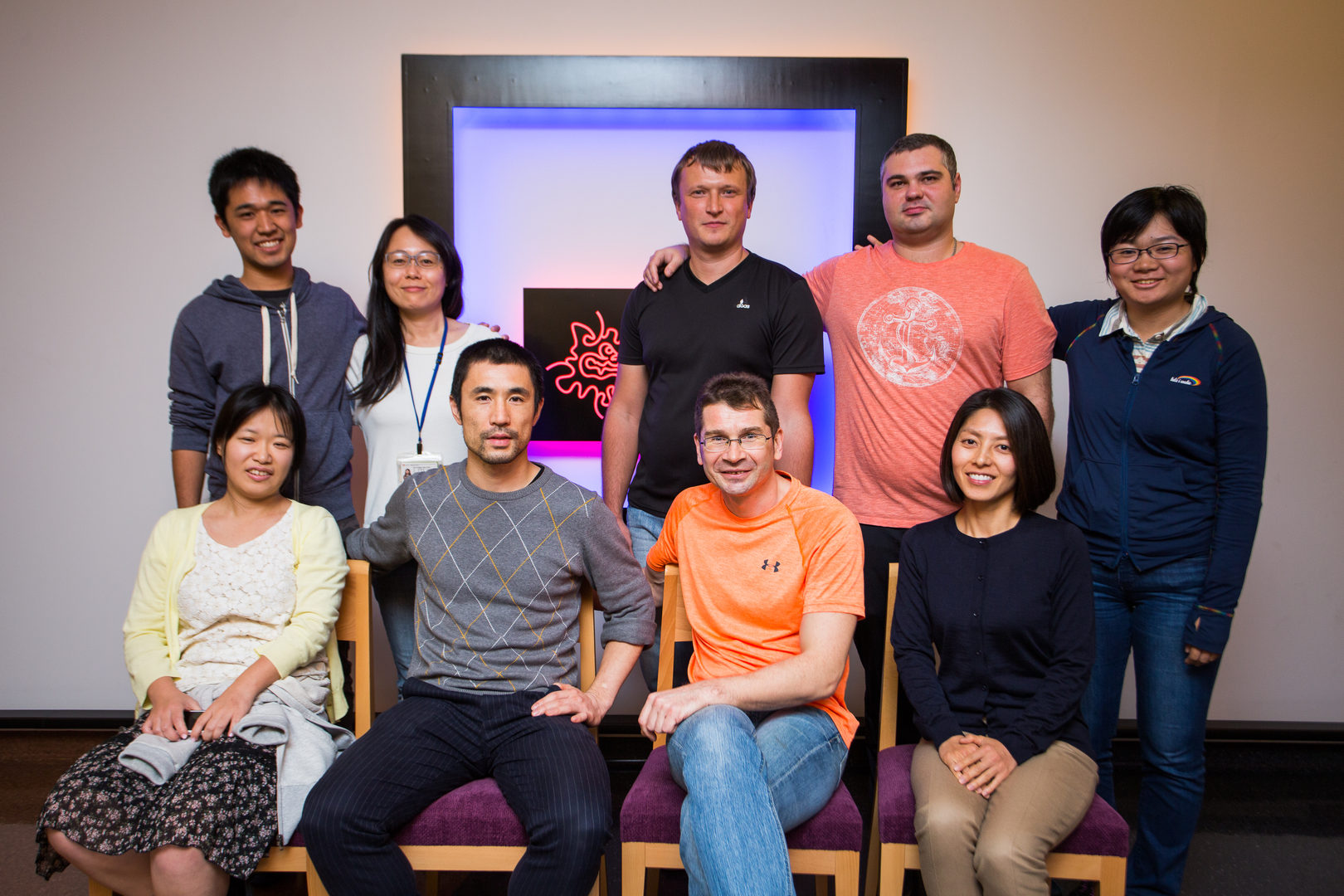
Left to right: (top) Yu Yamashiro, Jui-Yin Lin, Oleksiy Zadorozhko, Oleksandr Smorodin, Ayaka Usui (rotation student, OIST); (bottom) Erika Kawakami, Yuimaru Kubo, Denis Konstatinov, Taki Tazuke.
Abstract
In FY2016, we continued our studies of microwave-induced phenomena in 2D electrons on liquid helium, in particular the strong coupling regime of interaction bewteen 2D electrons on liquid helium and a single-mode microwave cavity resonator, as well as studies of electrical transport of 2D electrons confined in microchannels. We continued our studies of coupled electron-nuclear spin ensembles in solid antiferromagnets, in particular probing the predicted Bose-Einstein condensation of nuclear spin waves by the nonlinear NMR measurements. Finally, we successfully launched low-temperature experiments to study the electron spin resonance (ESR) in NV (nitrogen-vacancy) and P1 (substitutional nitrogen) centers in diamond.
1. Staff
- Dr. Yuimaru Kubo, Staff Scientist/Group Leader
- Dr. Erika Kawakami, Postdoc Scholar
- Dr. Oleksander Smorodin, Postdoc Scholar
- Dr. Oleksiy Zadorozhko, Postoc Scholar
- Dr. Viacheslav Dvornichenko, Technician
- Yu Yamashiro, Intern Student, University of Ryukyu
- Jason Ball, PhD OIST Student
- Jui-Yin Lin, PhD OIST Student
- Jiabao Chen, PhD OIST Student
- Taki Tazuke, Research Unit Administrator
2. Collaborations
2.1 Theme: Ripplonic Lamb shift of Rydberg energy levels in electrons on liquid helium
- Description: theoretical work on the coupling between the orbital motion of electrons on liquid helium and ripplons
- Type of collaboration: Joint research
- Researchers:
- Prof. Mark Dykman, Michigan State University
2.2 Theme: Transport of electrons through a microchannel T-junction
- Description: experiments with electrons on liquid helium confined in T-shaped microchanels
- Type of collaboration: Joint research
- Researchers:
- Dr. David Rees, National Chiao Tung University/Taiwan
2.3 Theme: BEC of nuclear spin waves probed by non-linear NMR
- Description: theoretical and experimental study of non-linear NMR signals in antiferromagnets with strong hyperfine intercation
- Type of collaboration: Joint research
- Researchers:
- Yuriy Bunkov/Institute Neel/CNRS/France
- Mihail Kurkin/Institute for Physics of Metals/Russian Academy of Science/Russia
- Anatoliy Tankevich/Ural Federal University/Russia
2.4 Theme: Quantum transducer using impurity spins in diamond
- Description: theoretical and experimental study of coherent conversion between optical and microwave photons using impurity spins in diamond
- Type of collaboration: Joint research
- Researchers:
- Tokuyuki Teraji/NIMS/Japan
- Jun-ichi Isoya/University of Tsukuba/Japan
3. Activities and Findings
3.1 Ripplonic Lamb shift of the Rydberg energy levels in electrons on helium (in collboration with Mark Dykman from Michigan State University) (link)
An electron on helium presents a unique clean quatum system. The orbital motion of such an electron perpendicular to the surface is quantized into a set of Rydberg states, and the energy levels of these states experience a shift due to the interaction of electron with the quantized capillary waves (ripplons), see Fig. 1 (left) . As in QED theory, the coupling between this quantum field of surface oscillations and electron leads to the diverging terms in the energy shifts, an analog of the ultraviolet catostrophe. We showed that there is cancelation of different divergent terms, thus reproducing an experimentally observed finit shift of the transtion frequency, see Fig. 1 (right).

Figure 1. (left) Artistic represenation of an electron above the surface of liquid helium disturbed by capilary waves (ripplons). (right) Ripplonic Lamb shift (squares) measured for electrons at different temperatures. The red line is our theoretical result obtained without any adjustable parameters.
3.2 Strong coupling between an electron ensemble and a single-mode 140 GHz Fabri-Perot cavity (E. Kawakami, O. Zadorozhko, A. Usui)
Last year we reported observation of the strong coupling regime of interaction between an ensemble of 2D electrons on liquid helium and a single-mode Fabri-Perot cavity resonator (see FY2015 Annual Report). This year, we have significantly improved our experimental setup, in particular achieving more than order of magnitude improvement in the quality factor of the resonator. This allowed us to observe several new features. First, we were able to resolve two modes corresponding to the right-hand circular polarized (or "active") mode showing two hybridized polaritonic branches of the cavity resonance, and the left-hand circular polarized (or "passive") mode showing no hybridization, see Fig. 2 (top), as should be expected. However, we have also observed an unexpected "faint" resonance revealed by taking the derivative of the power reflection signal, see Fig. 2 (bottom).
We have speculated that this resonace can originate from the "passive" mode due to the second-order (Raman) scattering processes involving ripplons. However, our calculations showed that such processes are to slow and can not account for the observed results. Further invetsigation is required.
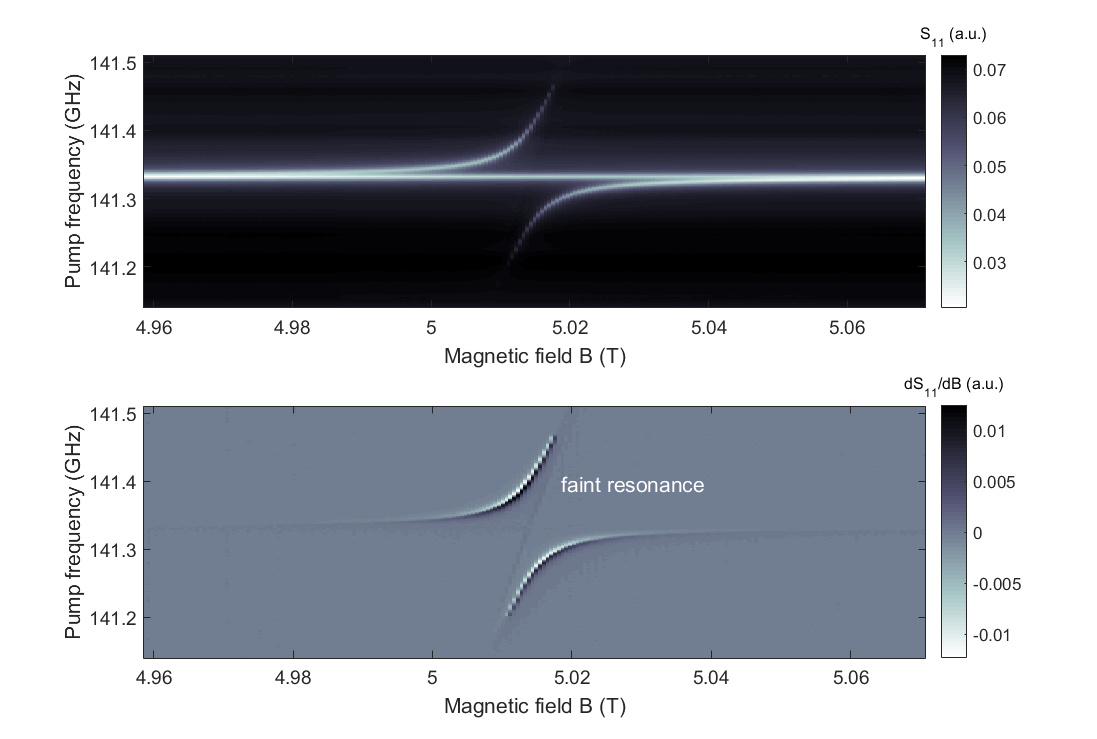
Figure 2. (top) Power reflection from the Fabri-Perot versus magnetic field B and pump frequency showing avoided crossing in the cavity spectrum for "active" mode and no frequancy change for "passive" mode. (bottom) The derivative of the above graph with respect to B reveals an additional "faint" resonance.
3.3 Transport of electrons through a microchannel T-junction (J.-Y. Lin, in collboration with David Rees from National Chiao Tung University and Alex Badrutdinov, Engineering and Microfabrication Support Section in OIST)
Electrical transport of 2D electrons on liquid helium has been of great interests for a long time. It is well enstablished that the electron motion parallel to the liquid surface is overdamped due to their coupling to ripplons and is well descrbed by the Drude model. However, deviations from the Dride regime can be expected due to strong electron-electron interaction, polaronic effects, etc.
To study the electrical DC transport of electrons, we have fabricated a unique device which consisted of three reservoirs for storage of electrons connected by a T-shaped microchannel through which electrons can flow, see Fig. 3 (top). By driving electrons from one reservoire (R1) into two remaining reservoirs (R2 and R3), we could study how the current of electrons splits at the T-junction. We have found that, unlike what is expected for the Drude transport regime, electrons can show a very strong assymetric flow, see Fig. 3 (bottom) indicating that electrons prefere to flow straight rather than turn at the junction. We speculate that this unusual behavior is associated with large inertia of electrons due to polaronic effects when electrons got self-trapped into ripplonic dimples formed by them on the liquid surface. More invetsigation is required to understand a perculiar temperature dependence, see FIg. 3 (bottom).
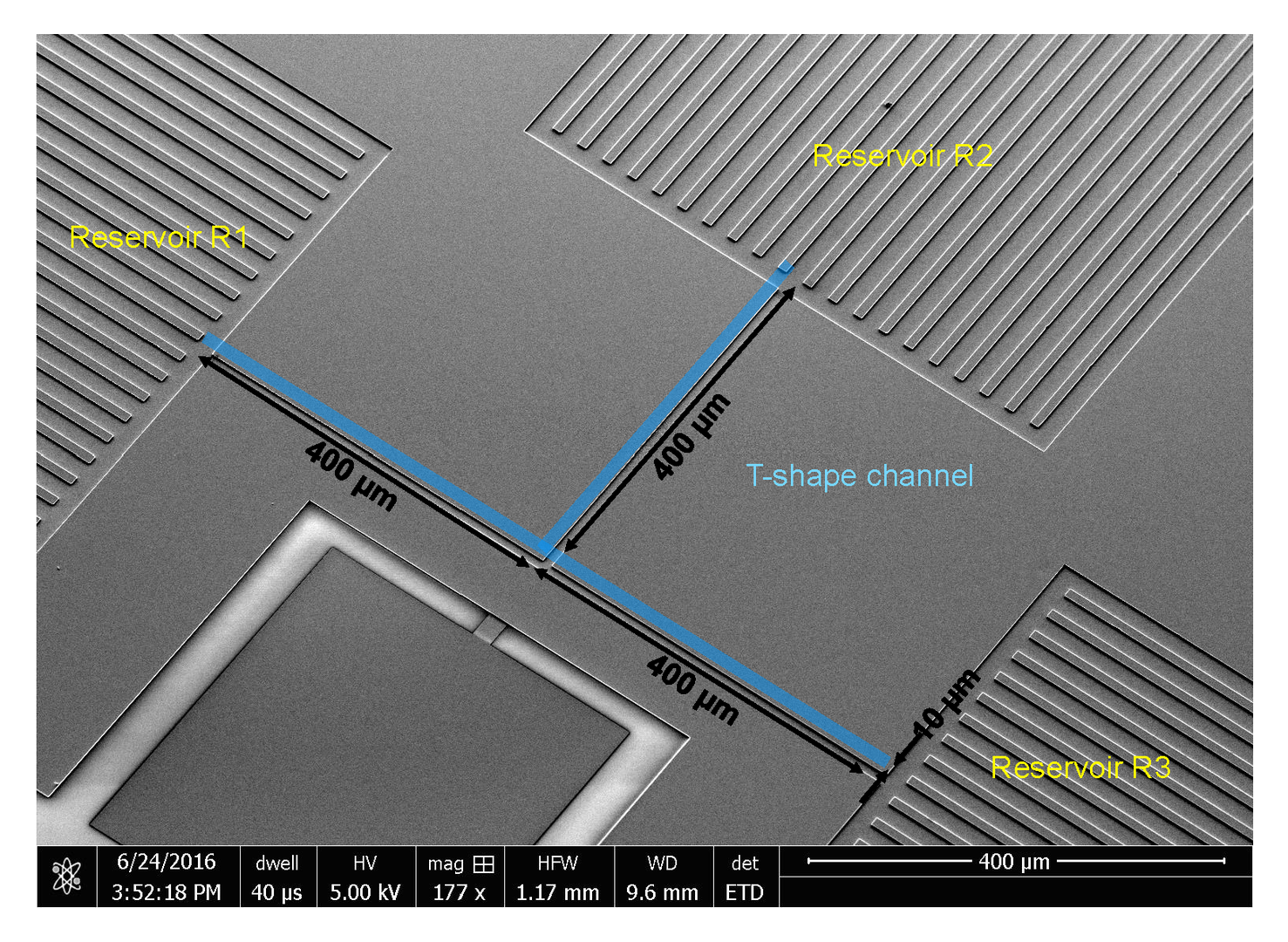

Figure 3. (top) Micrograph of the fabricated device consisting of three reservoirs for storage of electrons connected by a 10 micron wide and 1 microne deep T-shaped channel filled with liquid helium (indicated by blue). (bottom) The difference bewteen two currents of electrons split at the T-shaped juction shows strong assymetry at temperatres T<0.6 K, indicating that electrons do not follow symertric lines of force as expecetd for the Drude (overdamped) transport of electrons. Different lines are for diffferent temperatures indicated on the right.
3.4 Theoretical and experimental study of nonlinear NMR signals in MnCO3 antiferromagnet with strong hyperfine interaction (in collaboration with Yu. Bunkov from Institute Neel, CNRS, M. Kurkin from Institute for Physics of Metals, Russian Academy of Science, and A. Tankevich, Ural Federal University) (link)
We developed a theory and carried out experiments to investigate the shape of nonlinear NMR signals in a MnCO3 antiferromagnetic sample. It is known that the nonlinear NMR in this system arises because of a shift of the NMR frequency (“frequency pooling”) with increasing microwave excitation due to the strong hyperfine interaction of nuclear spins with ordered electron spin system. Traditionally, the observed effect is attributed to the heating of the nuclear spin system by the resonant excitation. We have carried out low-temperature measurements of both the in-phase (absorption) and quadrature (dispersion) components of the NMR signal at the increasing power of excitation, see Fig. 4 (top) and (middle). In order to explain the strongly nonlinear behavior of the observed signals we developed a theory which accounts for the indirect nuclear spin relaxation by their coupling to electron spins. We solved the linearized Landau-Lifshitz-Gilbert equations for coupled electron-nuclear spin system and compared the results of calculations (black dashed lines) with the experiment, see Fig. 4. Our model predicts deflection angles of the nuclear magnetization vector as large as 60 degrees for the highest microwave power used in the experiment. This is drastically different from the predictions of usual “heating” (Bloch) model which predicts small deflection angles but strong decrease of the magnitude of magnetization vector, see Fig. 4 (bottom). We argue that the large angle of deflection of nuclear magnetization vector, which preserves vector magnetude, can be associated with the coherent rotation of nuclear spins, thus the Bose-Einstein Condensation (BEC) of nuclear spin waves.
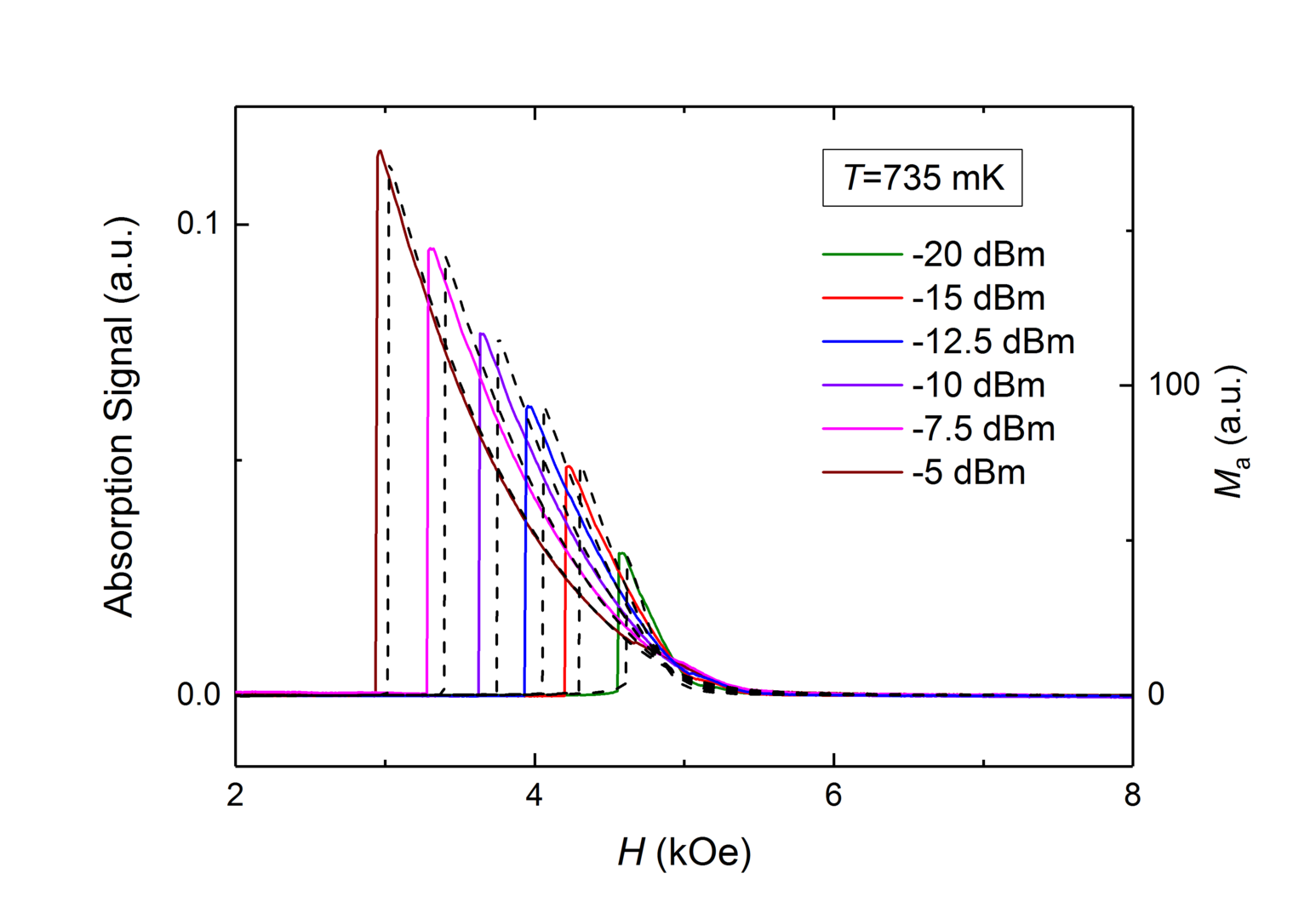
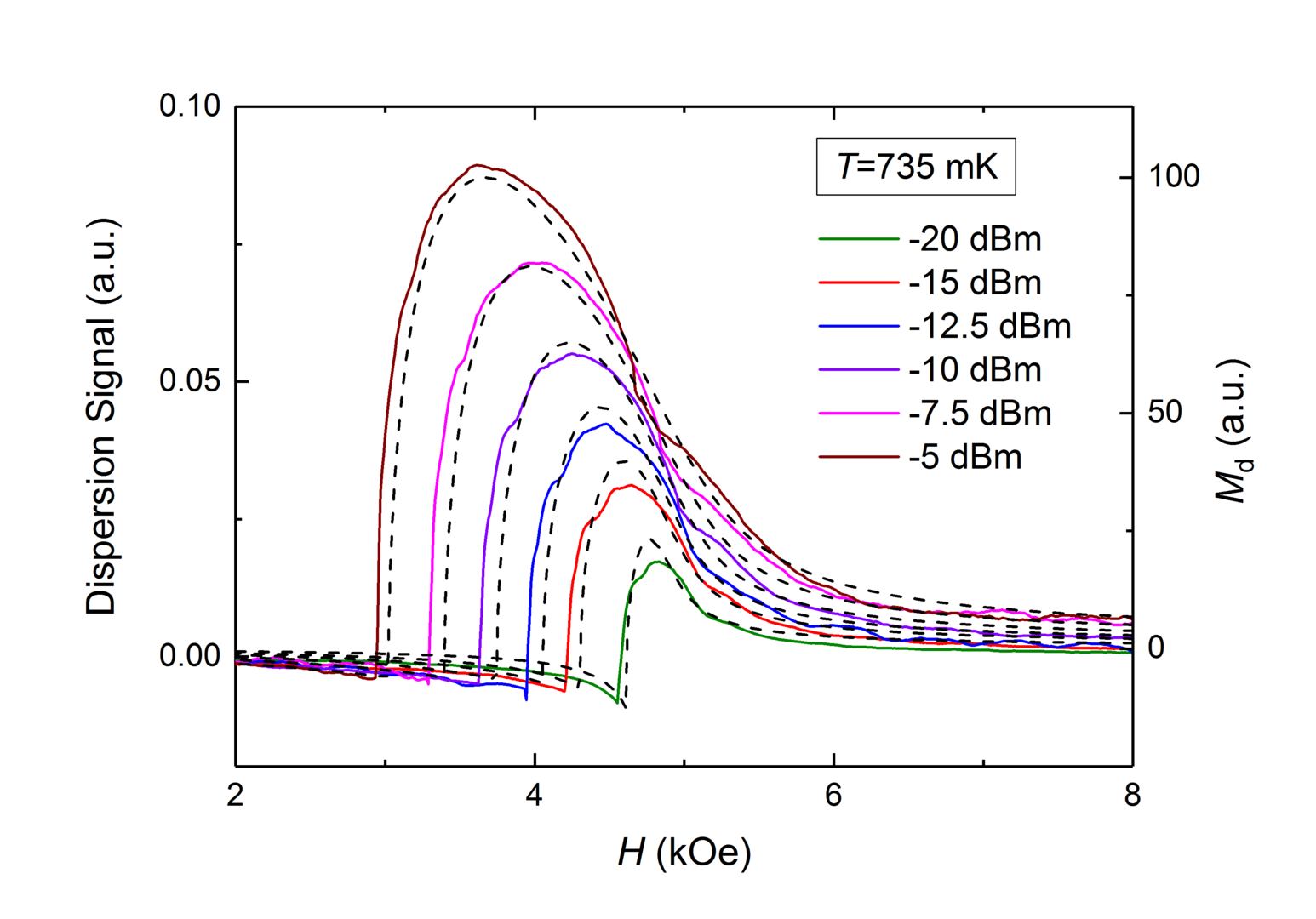
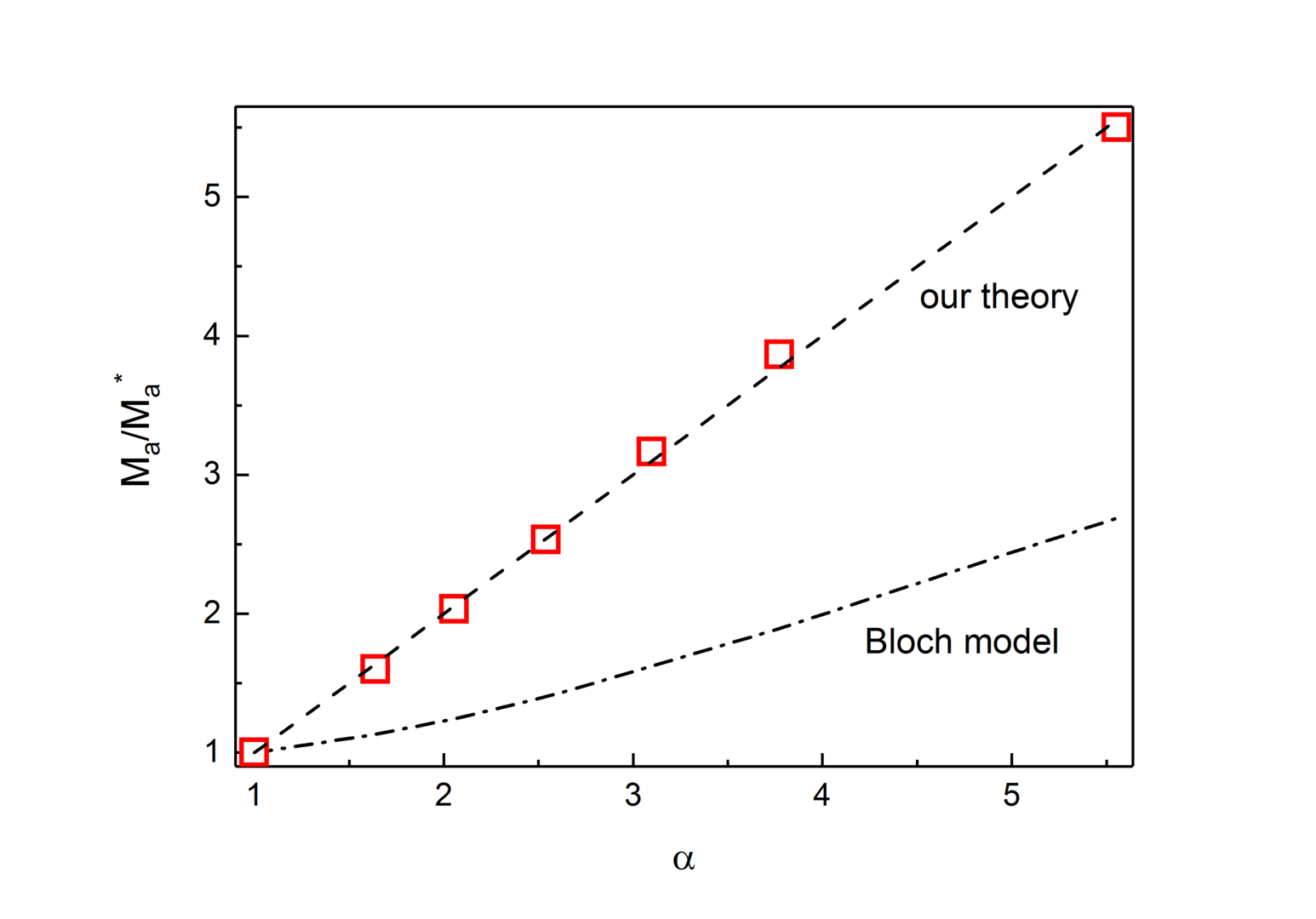
Figure 4. Absorption (top) and dispersion (middle) signals of nonlinear NMR measured at different excitation powers. The dashed lines are line shapes calculated by our theory. (bottom) Comparison between the experiment (red squares), conventional "heating" (Bloch) scenario (dash-dotted line) and our theory (dashed line).
4. Publications
4.1 Journals
-
A. O. Badrutdinov, A. V. Smorodin, D. G. Rees, J.-Y. Lin, D. Konstantinov, "Nonlinear transport of the inhomogeneous Wigner solid in a channel geometry", Phys. Rev. B 94, 195311, doi: https://doi.org/10.1103/PhysRevB.94.195311 (2016).
-
L. V. Abdurakhimov, R. Yamashiro, A. O. Badrutdinov, D. Konstantinov, "Strong coupling of the cyclotron motion of surface electrons on liquid helium in a microwave resonator", Phys. Rev. Lett. 177, 056803, doi:https://doi.org/10.1103/PhysRevLett.117.056803 (2016).
-
Y. Kubo,"Quantum engineering: Turn to the dark side", Nature Physics 12, 21-22, doi:https://doi.org/10.1038/nphys3582 (2016).
-
A. V. Smorodin, A. S. Rybalko, D. Konstantinov, "Measurements of complex permittivity of liquid Helium-4 in the millimeter-wave range by a Whispering-Gallery-Mode resonator", J. Low Temp. Phys. 187, 361-368, doi:https://doi.org/10.1007/s10909-017-1751-9 (2017).
-
P. Haikka, Y. Kubo, A. Bienfait, P. Bertet, K. Mølmer: "Proposal for detecting a single electron spin in a microwave resonator", Phys. Rev. A 95, 22306, doi:https://doi.org/10.1103/PhysRevA.95.022306 (2017).
4.2 Books and other one-time publications
Nothing to report
4.3 Oral and Poster Presentations
-
Denis Konstantinov, “Strong coupling of an electron ensemble on liquid helium to microwave cavity”, invited talk at the Annual Meeting of the American Physical Society (APS Meeting), (New Orleans, March 2017).
-
Jui-Yin Lin, “Suppression of Bragg-Cherenkov scattering of Wigner crystal on liquid helium in a periodic potential”, contributed talk at the 11th International Conference on Cryocrystals and Quantum Crystals (Turku, Finland, August 2016).
-
Leonid Abdurakhimov, “Strong coupling of hybrid nuclear-electron magnons to a microwave resonator” , contributed talk at Magnetism 2016 , (Sheffield, UK, April 2016).
-
Denis Konstantinov, "Surface electrons on liquid helium in a microwave cavity", invited talk at the Internationsl Workshop "RD2ES: Recent development in 2D electron systems", (Okinawa, Japan, April 2016).
-
Oleksandr Smorodin, "Measuremnst of dielectric properties of superfluidt Helium-4 using Wispering Gallery Mode resonator", poster at the International Symposium on Quatum Fluids and Solids, (Prague, Czech Repablic, August 2016).
5. Intellectual Property Rights and Other Specific Achievements
Nothing to report
6. Meetings and Events
6.1 OIST/Unit organized seminars
- Date: August 5, 2016
- Venue: OIST Campus Lab1, C016
- Speaker: Dr. Erika Kawakami (Qutech and Kavli Institute of Nanoscience, Delft University of Technology)
- Title: Physical realization of qubits using electrons confined in gate-defined quantum dots on a Si/SiGe two-dimensional electron gas
- Date: November 24, 2016
- Venue: OIST Campus Lab1, C016
- Speaker:Dr. Hitoshi Kitaguchi (Research Center for Functional Materials/ National Institute for Materials Science (NIMS), Tsukuba
- Title: Progress in Bi-2223 hight-Tc superconductor (HTS) development
- Date: Feburary 6, 2017
- Venue: OIST Campus Lab1, C016
- Speaker:Dr. Yutaka Shikano (National Institute of Nature Sciences, Institute for Molecular Science)
- Title: Toward Visualization of Quantum Dynamics
- Date: Feburary 28, 2017
- Venue: OIST Campus Lab1, C016
- Speaker:Dr. Eisuke Abe (Spintronics Research Center, Keio University)
- Title: Microwave engineering, magnetic sensing technique, and materials science for nitrogen-vacancy centers in diamond
6.2 OIST/Unit organized workshops
RD2DS-2016: Recent developments in 2D systems
- Date: April 4-April 8, 2016
- Venue: OIST Seaside House
- Co-organizers: Michael Zudov, University of Minnesota
- Program Committee:
- Dr. Koji Muraki (NTT basic Research Labs, Japan)
- Dr. Kostya Novoselov (Universiy of Manchester, UK)
- Dr. Jurgen Smet (Max Planck Institute for Solid State Research, Germany)
- Dr. Michael Zudov (Unviersity of Minnesota, USA)
OIST-JST Presto Joint Symposium on Frontiers in Optics and Photonics
- Date: October 31, 2016
- Venue: Room C210, OIST Central Building
- Co-organizers: Quantum Systems Unit (OIST), Light-Matter Interactions Unit (OIST), Optical Neuroimaging Unit (OIST), JST (PRESTO Program)
7. The Category or Type of Funding, like External Funding, Awards, etc.
Grant-in-Aids for Scientific Research (KAKENHI MEXT), Scientific Research (C), “Spin superfluidity in solid antiferromagnets” (反強磁性体におけるスピン超流動の核磁気共鳴研究).
JST-PRESTO: “Coherent Bidirectional Conversion between Optical and Microwave Photons using Electron Spins in Solids” (固体中の電子スピンを用いた光-マイクロ波のコヒーレント相互変換)



